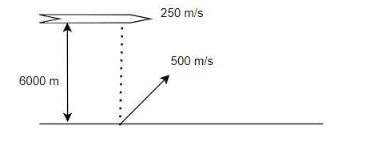
An aircraft moving with a speed of $250\,m{s^{ - 1}}$ is at a height of $6000\,m$, just overhead of an anti-aircraft- gun. If the muzzle velocity is $500\,m{s^{ - 1}}$ , the firing angle $\theta $ should be:

(A) ${30^ \circ }$
(B) ${45^ \circ }$
(C) ${60^ \circ }$
(D) ${75^ \circ }$

Answer
558k+ views
Hint:Observe the given diagram and split the velocity of the muzzle into the horizontal component and the vertical component. Equate the horizontal component of the velocity of the muzzle to the velocity of the aircraft, to find out the firing angle of the gun.
Complete step by step solution:
Given,
Speed of the aircraft, $V = 250\,m{s^{ - 1}}$
The speed of the muzzle, $v = 500\,m{s^{ - 1}}$
The aircraft flies at the height, $h = 6000\,m$
The muzzle velocity is inclined to a certain angle, so that it can fire the aircraft. So this inclined velocity is separated into the vertical component as $500\sin \theta $ and the horizontal component as $500\cos \theta $ . This separation of the horizontal and the vertical component helps us to calculate the angle of the inclination of the gun to fire the aircraft.
Since the horizontal component of the gun and the aircraft are straight to each other and moves in the similar direction,
$500\cos \theta = 250$
By grouping the similar terms in both sides of the equation, we get
$\cos \theta = \dfrac{1}{2}$
In order to find the angle of the inclination, the cos is taken as the inverse in the right hand side of the equation,
$\theta = {\cos ^{ - 1}}\left( {\dfrac{1}{2}} \right) = {60^ \circ }$
Thus the firing angle ${60^ \circ }$ is needed to fight the aircraft with the help of the muzzle.
Thus the option (C) is correct.
Note:While separating the components of the velocity, the $\sin \theta $ is taken as the vertical component and the $\cos \theta $ is considered as the horizontal component. This is because the horizontal component must have a larger value, since the least value of the $\cos $ is $1$ and it still increases further. But $\sin \theta $ values range from $0\,to\,1$ .
Complete step by step solution:
Given,
Speed of the aircraft, $V = 250\,m{s^{ - 1}}$
The speed of the muzzle, $v = 500\,m{s^{ - 1}}$
The aircraft flies at the height, $h = 6000\,m$
The muzzle velocity is inclined to a certain angle, so that it can fire the aircraft. So this inclined velocity is separated into the vertical component as $500\sin \theta $ and the horizontal component as $500\cos \theta $ . This separation of the horizontal and the vertical component helps us to calculate the angle of the inclination of the gun to fire the aircraft.
Since the horizontal component of the gun and the aircraft are straight to each other and moves in the similar direction,
$500\cos \theta = 250$
By grouping the similar terms in both sides of the equation, we get
$\cos \theta = \dfrac{1}{2}$
In order to find the angle of the inclination, the cos is taken as the inverse in the right hand side of the equation,
$\theta = {\cos ^{ - 1}}\left( {\dfrac{1}{2}} \right) = {60^ \circ }$
Thus the firing angle ${60^ \circ }$ is needed to fight the aircraft with the help of the muzzle.
Thus the option (C) is correct.
Note:While separating the components of the velocity, the $\sin \theta $ is taken as the vertical component and the $\cos \theta $ is considered as the horizontal component. This is because the horizontal component must have a larger value, since the least value of the $\cos $ is $1$ and it still increases further. But $\sin \theta $ values range from $0\,to\,1$ .
Recently Updated Pages
Why are manures considered better than fertilizers class 11 biology CBSE

Find the coordinates of the midpoint of the line segment class 11 maths CBSE

Distinguish between static friction limiting friction class 11 physics CBSE

The Chairman of the constituent Assembly was A Jawaharlal class 11 social science CBSE

The first National Commission on Labour NCL submitted class 11 social science CBSE

Number of all subshell of n + l 7 is A 4 B 5 C 6 D class 11 chemistry CBSE

Trending doubts
What is meant by exothermic and endothermic reactions class 11 chemistry CBSE

10 examples of friction in our daily life

One Metric ton is equal to kg A 10000 B 1000 C 100 class 11 physics CBSE

1 Quintal is equal to a 110 kg b 10 kg c 100kg d 1000 class 11 physics CBSE

Difference Between Prokaryotic Cells and Eukaryotic Cells

What are Quantum numbers Explain the quantum number class 11 chemistry CBSE




